King Salmon are also the largest of the 5 species of Pacific salmon with the Alaska rod and reel record being a 97 pounder. A King has to be at least 50 pounds to be considered a trophy! They are a highly prized and sought after sport fishing fish as well and bring in anglers from all over the world to Alaska hoping to hook into one of these beauties. They are also the Kings of salmon because of their amazing ability to shake a hook, break your line, or escape from the net in some other way! An experienced King fisherman has mastered a system to maximize the odds of landing one of these fish amidst the chaos that erupts when a pole jerks and that thrilling sound of line ripping off the reel gets the adrenaline flowing and the heart racing.
Unfortunately, the return of Kings is expected to be low so we are limited to just one fish a day with nonresidents only allowed 3 Kings per year. Kings always have to be at least 28" long to be a legal fish.
The scientific name of King Salmon is, Oncorynchus tshawytscha. Oncorhychus means "nail snout" or "bone nose" and is the genus that all 5 Pacific salmon species are classified. Tshawytscha is the vernacular name of King Salmon in Kamchatka, Russia.
Another interesting thing about King Salmon is that there are white kings, red kings, marbled kings, and peach kings. This is referring to the color of their flesh which is usually the well known classic salmon red color but some kings have pale flesh (white), some have a mix of red and white (marbled) and then there are some that are a pale pink color (peach). These differences may be due to a difference in prey consumption or genetic but most importantly, it is not a bad thing. The white and peach kings are actually preferred to the classic red by many of us. White kings are richer and more oily and melt in your mouth when taken off the grill! (My salivary glands just perked up at the mention of white king off the grill!)
One way to identify whether or not your salmon is a king is by looking in its mouth, if the inside of its mouth and gums are black, you've got a king. One other way is to look at its tail, large black spots on both lobes? A King!
There is a sea lion rookery on one of the smaller islands near Wrangell at the edge of the Stikine delta where the Steller's sea lions congregate in the spring to feast on the hooligan and herring that spawn. There seem to be more and more every year. In one photo that I took which showed maybe only half of the group, I counted over 250 so my guess is that there where somewhere around 400 or 500 animals hauled out on the rocks. This was not counting the ones swimming!
Sea lions, seals, and walruses are known as pinnipeds which means "fin foot". They are further classified as eared or earless seals which refers to whether or not they have a visible external ear like we do. These sea lions are "eared" as you can see small ears behind their eyes whereas harbor seals have no external ears.
If I were to compare sea lions and seals to a terrestrial mammal, I would say harbor seals make me think of aquatic dogs but sea lions, sea lions are the grizzly bears of the sea. They have occasionally attacked people on docks and boats and are fairly intimidating when you are close to them in a kayak or small skiff. The males especially are huge and they have some large canine teeth. During this spring season when the hooligan are running up the Stikine, sea lions will travel as far as 15-20 miles upriver.
Just some neon green seaweed that looked nice on the rocks at low tide. This is called Emerald Carpet and is a type of green algae. Interestingly, this seaweed is usually found near bird rookeries are other place where birds congregate as it relies on bird guano. There is no rookery near this patch but there is a large spruce tree very close where eagles perch regularly on this was on a high, narrow band of rock that would make a great perch for gulls and other sea birds to perch to scan the waters below.







No comments:
Post a Comment